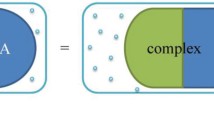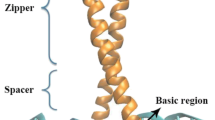Abstract
The basic helix-loop-helix (bHLH) family members DEC1 and DEC2 function as transcription factors by directly binding to class B E-box region in the proximal promoter of target genes, and have recently been reported to play important roles in many human physiological and pathological processes such as cancer. However, it is a great challenge to quantitatively analyze the binding affinity and selectivity of sequence-specific interaction in DEC1/DEC2–E-box recognition since there are numerous potential competitive DNA binders of the transcription factors in cellular context. In the present study, we describe a novel model peptide approach to fast and reliably characterize the interaction behavior of DEC1 and DEC2 with DNA. In the procedure, a series of peptides that mimic the DNA recognition helices of DEC1 and DEC2 as well as other bHLH proteins are derived, and their binding potencies to cognate E-box and noncognate DNA decoys are evaluated using a residue-level affinity predictor built upon a distinct set of structure-solved, affinity-known protein–DNA complexes. By systematically examining the affinity distribution profiles of different peptides binding to the E-box and to a large number of decoys it is found that single-point mutations on peptide key residues such as H6A and R14A can significantly reduce both the affinity and selectivity of DEC1 and DEC2 toward E-box, but the mutations do not substantially influence their binding capability to most decoys, and a fraction (~22 %) of DNA decoys exhibit stronger interaction potency with DEC peptide as compared to E-box, suggesting that the DEC1 and DEC2 possess a moderate specificity that allows the transcription factors to bind, and regulate, a number of potential target genes.





Similar content being viewed by others
References
Atchley WR, Fitch WM (1997) A natural classification of the basic helix-loop-helix class of transcription factors. Proc Natl Acad Sci USA 94:5172–5176
Berman HM, Westbrook J, Feng Z, Gilliland G, Bhat TN, Weissig H, Shindyalov IN, Bourne PE (2000) The protein data bank. Nucleic Acids Res 28:235–242
Boulesteix AL, Strimmer K (2007) Partial least squares: a versatile tool for the analysis of high-dimensional genomic data. Brief Bioinform 8:32–44
Chakrabarti J, Turley H, Campo L, Han C, Harris AL, Gatter KC, Fox SB (2004) The transcription factor DEC1 (stra13, SHARP2) is associated with the hypoxic response and high tumour grade in human breast cancers. Br J Cancer 91:954–958
Elrod-Erickson M, Rould MA, Nekludova L, Pabo CO (1996) Zif268 protein–DNA complex refined at 1.6 Å: a model system for understanding zinc finger–DNA interactions. Structure 4:1171–1180
Fujimoto K, Shen M, Noshiro M, Matsubara K, Shingu S, Honda K, Yoshida E, Suardita K, Matsuda Y, Kato Y (2001) Molecular cloning and characterization of DEC2, a new member of basic helix-loop-helix proteins. Biochem Biophys Res Commun 280:164–171
Giatromanolaki A, Koukourakis MI, Sivridis E, Turley H, Wykoff CC, Gatter KC, Harris AL (2003) DEC1 (STRA13) protein expression relates to hypoxia-inducible factor 1-alpha and carbonic anhydrase-9 overexpression in non-small cell lung cancer. J Pathol 200:222–228
Golbraikh A, Tropsha A (2002) Beware of q 2! J Mol Graph Model 20:269–276
Gordân R, Shen N, Dror I, Zhou T, Horton J, Rohs R, Bulyk ML (2013) Genomic regions flanking E-box binding sites influence DNA binding specificity of bHLH transcription factors through DNA shape. Cell Rep 3:1093–1104
He P, Wu W, Wang HD, Yang K, Liao KL, Zhang W (2010) Toward quantitative characterization of the binding profile between the human amphiphysin-1 SH3 domain and its peptide ligands. Amino Acids 38:1209–1218
Honma S, Kawamoto T, Takagi Y, Fujimoto K, Sato F, Noshiro M, Kato Y, Honma K (2002) Dec1 and Dec2 are regulators of the mammalian molecular clock. Nature 419:841–844
Jia YF, Xiao DJ, Ma XL, Song YY, Hu R, Kong Y, Zheng Y, Han SY, Hong RL, Wang YS (2013) Differentiated embryonic chondrocyte-expressed gene 1 is associated with hypoxia-inducible factor 1α and Ki67 in human gastric cancer. Diagn Pathol 8:37
Jin R, Ma Y, Qin L, Ni Z (2013) Structure-based prediction of domain-peptide binding affinity by dissecting residue interaction profile at complex interface: a case study on CAL PDZ domain. Protein Pept Lett (in press)
Jolma A, Yan J, Whitington T, Toivonen J, Nitta KR, Rastas P, Morgunova E, Enge M, Taipale M, Wei G, Palin K, Vaquerizas JM, Vincentelli R, Luscombe NM, Hughes TR, Lemaire P, Ukkonen E, Kivioja T, Taipale J (2013) DNA-binding specificities of human transcription factors. Cell 152:327–339
Jorgensen WL, Maxwell DS, Tirado-Rives J (1996) Development and testing of the OPLS all-atom force field on conformational energetics and properties of organic liquids. J Am Chem Soc 118:11225–11236
Krivov GG, Shapovalov MV, Dunbrack RL Jr (2009) Improved prediction of protein side-chain conformations with SCWRL4. Proteins 77:778–795
Li Y, Xie M, Song X, Gragen S, Sachdeva K, Wan Y, Yan B (2003) DEC1 negatively regulates the expression of DEC2 through binding to the E-box in the proximal promoter. J Biol Chem 278:16899–16907
Liu Y, Sato F, Kawamoto T, Fujimoto K, Morohashi S, Akasaka H, Kondo J, Wu Y, Noshiro M, Kato Y, Kijima H (2010) Anti-apoptotic effect of the basic helix-loop-helix (bHLH) transcription factor DEC2 in human breast cancer cells. Genes Cells 15:315–325
Lu XJ, Olson WK (2008) 3DNA: a versatile, integrated software system for the analysis, rebuilding and visualization of three-dimensional nucleic-acid structures. Nat Protoc 3:1213–1227
Ning J, Chen W, Li J, Peng Z, Wang J, Ni Z (2013) Structural and energetic insights into sequence-specific interaction in DNA–drug recognition: development of affinity predictor and analysis of binding selectivity. J Mol Model 19:1573–1582
Qian Y, Zhang J, Yan B, Chen X (2008) DEC1, a basic helix-loop-helix transcription factor and a novel target gene of the p53 family, mediates p53-dependent premature senescence. J Biol Chem 283:2896–2905
Sato F, Kawamoto T, Fujimoto K, Noshiro M, Honda KK, Honma S, Honma K, Kato Y (2004) Functional analysis of the basic helix-loop-helix transcription factor DEC1 in circadian regulation. Interaction with BMAL1. Eur J Biochem 271:4409–4419
Sato F, Bhawal UK, Kawamoto T, Fujimoto K, Imaizumi T, Imanaka T, Kondo J, Koyanagi S, Noshiro M, Yoshida H, Kusumi T, Kato Y, Kijima H (2008) Basic-helix-loop-helix (bHLH) transcription factor DEC2 negatively regulates vascular endothelial growth factor expression. Genes Cells 13:131–144
Segal DJ, Dreier B, Beerli RR, Barbas CF (1999) Toward controlling gene expression at will: selection and design of zinc finger domains recognizing each of the 5′-GNN-3′ DNA target sequences. Proc Natl Acad Sci USA 96:2758–2763
Tian F, Yang L, Lv F, Yang Q, Zhou P (2009) In silico quantitative prediction of peptides binding affinity to human MHC molecule: an intuitive quantitative structure–activity relationship approach. Amino Acids 36:535–554
Wang X, Zhang A, Ren W, Chen C, Dong J (2012) Genome-wide inference of transcription factor–DNA binding specificity in cell regeneration using a combination strategy. Chem Biol Drug Des 80:734–744
Wu J, Aluko RE, Nakai S (2006) Structural requirements of Angiotensin I-converting enzyme inhibitory peptides: quantitative structure–activity relationship study of di- and tripeptides. J Agric Food Chem 54:732–738
Wu Y, Sato F, Bhawal UK, Kawamoto T, Fujimoto K, Noshiro M, Morohashi S, Kato Y, Kijima H (2011) Basic helix-loop-helix transcription factors DEC1 and DEC2 regulate the paclitaxel-induced apoptotic pathway of MCF-7 human breast cancer cells. Int J Mol Med 27:491–495
Zhang C, Liu S, Zhu Q, Zhou Y (2005) A knowledge-based energy function for protein–ligand, protein–protein, and protein–DNA complexes. J Med Chem 48:2325–2335
Zhou P, Tian F, Ren Y, Shang Z (2010) Systematic classification and analysis of themes in protein–DNA recognition. J Chem Inf Model 50:1476–1488
Zhou P, Wang C, Tian F, Ren Y, Yang C, Huang J (2013a) Biomacromolecular quantitative structure–activity relationship (BioQSAR): a proof-of-concept study on the modeling, prediction and interpretation of protein–protein binding affinity. J Comput Aided Mol Des 27:67–78
Zhou P, Wang C, Ren Y, Yang C, Tian F (2013b) Computational peptidology: a new and promising approach to therapeutic peptide design. Curr Med Chem 20:1985–1996
Acknowledgments
This work was supported by the Key Project of Science and Technique Foundation of the Department of Education of Guangxi Zhuang Autonomous Region (No. 2013ZD045), the National Key Basic Research Program of China (973 Program) (Nos. 2011CBA00800 and 2009CB724700) and the Open Funding Project of the State Key Laboratory of Bioreactor Engineering.
Author information
Authors and Affiliations
Corresponding author
Additional information
Rongzhong Jin and Yili Ma contributed equally to this work.
Electronic supplementary material
Below is the link to the electronic supplementary material.
Rights and permissions
About this article
Cite this article
Jin, R., Ma, Y. & Chen, H. Structural and Affinity Insight into the Sequence-Specific Interaction of Transcription Factors DEC1 and DEC2 with E-box DNA: A Novel Model Peptide Approach. Int J Pept Res Ther 19, 313–321 (2013). https://doi.org/10.1007/s10989-013-9354-z
Accepted:
Published:
Issue Date:
DOI: https://doi.org/10.1007/s10989-013-9354-z




